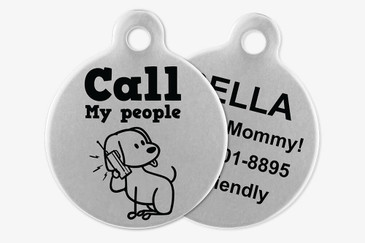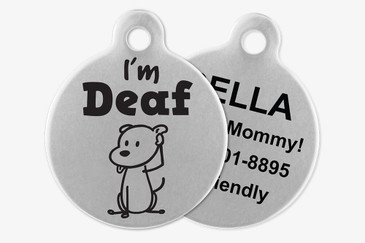Find a tag for your new collar
A huge variety to choose from
All of our Pet ID Tags come with your dog’s name and an additional four lines of text, so you can add your phone number, address, or a message. Is your dog microchipped? Say so on the tag!
Find a new collar for your tag!
Order your new ID tag here
A Complete Guide to Pet Identification
When a pet goes missing, the golden window to successfully find your pet is the first 12 hours after their disappearance. Nearly 90% of lost pets are recovered within the first 12 hours if their owners are actively searching for them. After that, the chances of finding them reduces significantly with each second that passes.
One of the most influential factors in having your lost pet returned to you is by them wearing some form of identification when they get lost, but there is controversy over what type is best. Truthfully, anything is better than nothing, but the best answer is a collar with some form of ID, in conjunction with a secondary form of ID.
Your dog's primary identification
Benefits of ID Tags & Plates:
- Provides instant identification of your pet.
- ID tags are easily readable by anyone without the use of technology.
- They are readily available, inexpensive, and fully customizable.
- This single item is the most useful form of identification to have your lost pet returned to you, and quickly.
Drawbacks of ID Tags:
- Potential safety risk as they can become hooked or caught while your dog is running or playing.
- Can become detached and lost.
- Several tags together can become bulky.
- Tags can be noisy from the jingle of metal on metal.
My dog has a microchip, why do they need to wear ID on their collar?
What information should I include?
- Your Pet’s name
- One or two phone numbers to contact you
- A personal message like “I am microchipped" or “Call my mom" or “I’m friendly".
- Your city
Do I include my pet’s name?
What contact information should I include?
Should I include an alternate phone number?

Should I include my name?
What about my address?
My dog has a microchip. Should I include a line like “I’m microchipped" to my dog’s tag?
- It provides a prompt for the finder to have your pet scanned.
- Microchips can migrate from their injection site. If the animal’s tag insists the animal is indeed microchipped but nothing is showing on the scanner, it gives the message that it is there, so please keep looking.
- When your pet is scanned at a vet office or animal shelter, the owner information can be verified. When a pet is found, the finder wants to ensure they are returning the animal to the rightful owner and this would allow them to check the credentials of whoever comes forward to claim the pet.
- Because microchips are irrefutable proof of ownership and can not be removed, it will ward off anyone with ill intentions of acquiring your pet as their own or offering them for sale as the dog can be traced back to an owner (yes, sadly these things happen).
Why would I include Medical Information for my pet on their ID tag?
- This puts an urgency on the finder to reunite the pet with the owner, sooner.
- It can help deter someone who found your dog and considering keeping them as their own.
- Your dog may need treatment or medication when found. The finder is more likely to seek veterinary assistance in this case and get the required help for your dog.
Should I include information about a “Reward" for the safe return of my pet?
Should I include a personalized message?
Microchips & Tattoos: Secondary Identification
Microchips

Microchip Pros:
- Long lasting, permanent ID
- Can be inserted without sedation
Microchip Cons:
- Require a chip scanner and database to contact owner
- More expensive initial cost and/or require a database maintenance fee/subscription
Tattoos

Tattoo Pros:
- Generally inexpensive
- One time application/permanent ID
- Readable by anyone (without the use of technology)
Tattoo Cons:
- Hidden by hair or fade over time making them difficult to read
- Requires the animal to be sedated to tattoo
- Need use of database to track to the owner

















